ESP FIAT FREEMONT 2011 Owner handbook (in English)
[x] Cancel search | Manufacturer: FIAT, Model Year: 2011, Model line: FREEMONT, Model: FIAT FREEMONT 2011Pages: 267, PDF Size: 5.16 MB
Page 234 of 267
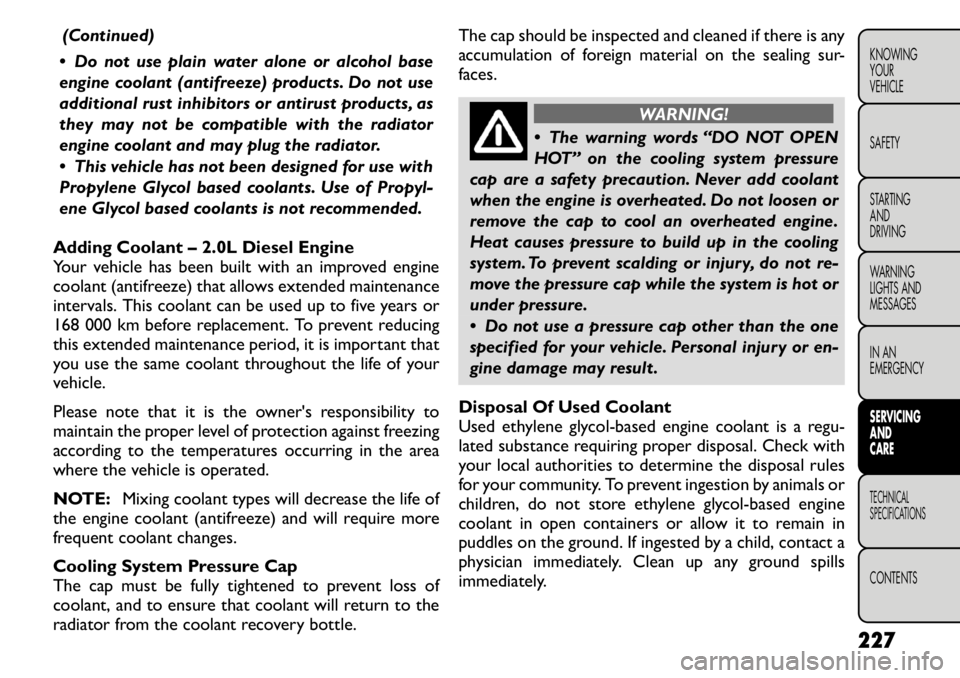
(Continued)
Do not use plain water alone or alcohol base
engine coolant (antifreeze) products. Do not use
additional rust inhibitors or antirust products, as
they may not be compatible with the radiator
engine coolant and may plug the radiator.
This vehicle has not been designed for use with
Propylene Glycol based coolants. Use of Propyl-
ene Glycol based coolants is not recommended.
Adding Coolant – 2.0L Diesel Engine
Your vehicle has been built with an improved engine
coolant (antifreeze) that allows extended maintenance
intervals. This coolant can be used up to five years or
168 000 km before replacement. To prevent reducing
this extended maintenance period, it is important that
you use the same coolant throughout the life of your
vehicle.
Please note that it is the owner's responsibility to
maintain the proper level of protection against freezing
according to the temperatures occurring in the area
where the vehicle is operated.
NOTE: Mixing coolant types will decrease the life of
the engine coolant (antifreeze) and will require more
frequent coolant changes.
Cooling System Pressure Cap
The cap must be fully tightened to prevent loss of
coolant, and to ensure that coolant will return to the
radiator from the coolant recovery bottle. The cap should be inspected and cleaned if there is any
accumulation of foreign material on the sealing sur-
faces.
WARNING!
The warning words “DO NOT OPEN
HOT” on the cooling system pressure
cap are a safety precaution. Never add coolant
when the engine is overheated. Do not loosen or
remove the cap to cool an overheated engine.
Heat causes pressure to build up in the cooling
system. To prevent scalding or injury, do not re-
move the pressure cap while the system is hot or
under pressure.
Do not use a pressure cap other than the one
specified for your vehicle. Personal injury or en-
gine damage may result .
Disposal Of Used Coolant
Used ethylene glycol-based engine coolant is a regu-
lated substance requiring proper disposal. Check with
your local authorities to determine the disposal rules
for your community. To prevent ingestion by animals or
children, do not store ethylene glycol-based engine
coolant in open containers or allow it to remain in
puddles on the ground. If ingested by a child, contact a
physician immediately. Clean up any ground spills
immediately.
227
KNOWING
YOURVEHICLE SAFETY
STARTING ANDDRIVING
WARNING
LIGHTS AND
MESSAGES
IN AN
EMERGENCYSERVICING AND
CARETECHNICAL
SPECIFICATIONSCONTENTS
Page 238 of 267
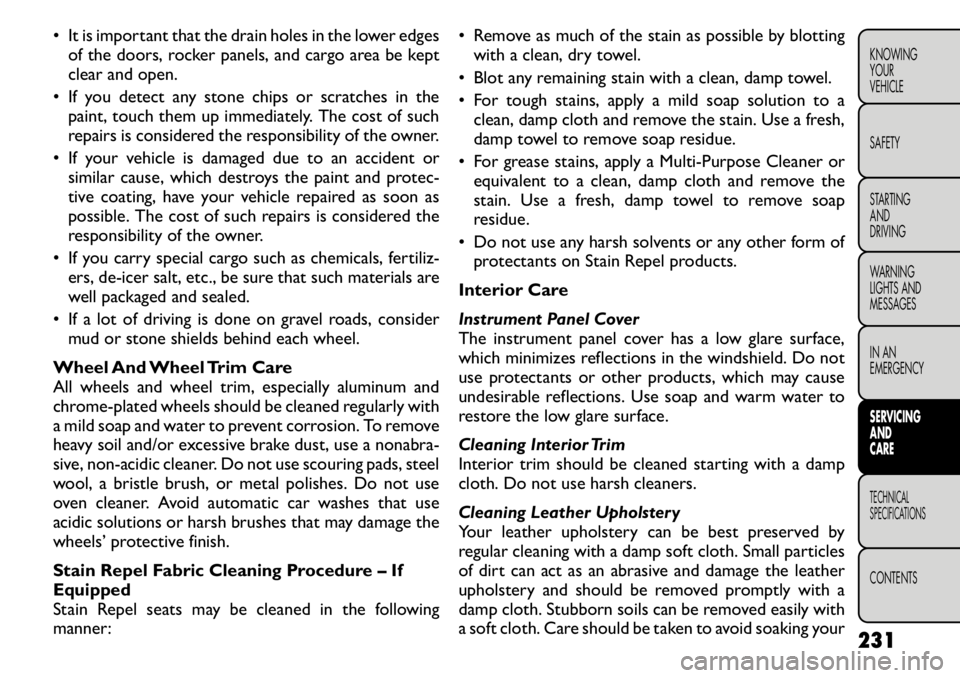
• It is important that the drain holes in the lower edgesof the doors, rocker panels, and cargo area be kept
clear and open.
• If you detect any stone chips or scratches in the paint, touch them up immediately. The cost of such
repairs is considered the responsibility of the owner.
• If your vehicle is damaged due to an accident or similar cause, which destroys the paint and protec-
tive coating, have your vehicle repaired as soon as
possible. The cost of such repairs is considered the
responsibility of the owner.
• If you carry special cargo such as chemicals, fertiliz- ers, de-icer salt, etc., be sure that such materials are
well packaged and sealed.
• If a lot of driving is done on gravel roads, consider mud or stone shields behind each wheel.
Wheel And Wheel Trim Care
All wheels and wheel trim, especially aluminum and
chrome-plated wheels should be cleaned regularly with
a mild soap and water to prevent corrosion. To remove
heavy soil and/or excessive brake dust, use a nonabra-
sive, non-acidic cleaner. Do not use scouring pads, steel
wool, a bristle brush, or metal polishes. Do not use
oven cleaner. Avoid automatic car washes that use
acidic solutions or harsh brushes that may damage the
wheels’ protective finish.
Stain Repel Fabric Cleaning Procedure – If
Equipped
Stain Repel seats may be cleaned in the following
manner: • Remove as much of the stain as possible by blotting
with a clean, dry towel.
• Blot any remaining stain with a clean, damp towel.
• For tough stains, apply a mild soap solution to a clean, damp cloth and remove the stain. Use a fresh,
damp towel to remove soap residue.
• For grease stains, apply a Multi-Purpose Cleaner or equivalent to a clean, damp cloth and remove the
stain. Use a fresh, damp towel to remove soap
residue.
• Do not use any harsh solvents or any other form of protectants on Stain Repel products.
Interior Care
Instrument Panel Cover
The instrument panel cover has a low glare surface,
which minimizes reflections in the windshield. Do not
use protectants or other products, which may cause
undesirable reflections. Use soap and warm water to
restore the low glare surface.
Cleaning Interior Trim
Interior trim should be cleaned starting with a damp
cloth. Do not use harsh cleaners.
Cleaning Leather Upholstery
Your leather upholstery can be best preserved by
regular cleaning with a damp soft cloth. Small particles
of dirt can act as an abrasive and damage the leather
upholstery and should be removed promptly with a
damp cloth. Stubborn soils can be removed easily with
a soft cloth. Care should be taken to avoid soaking your 231
KNOWING
YOURVEHICLE SAFETY
STARTING ANDDRIVING
WARNING
LIGHTS AND
MESSAGES
IN AN
EMERGENCYSERVICING AND
CARETECHNICAL
SPECIFICATIONSCONTENTS
Page 239 of 267
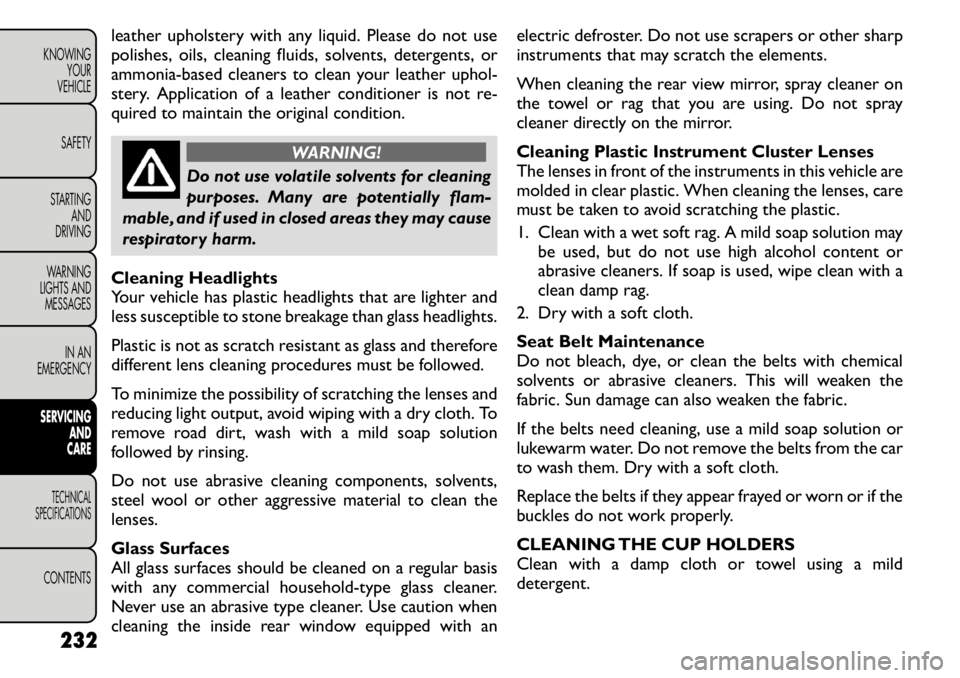
leather upholstery with any liquid. Please do not use
polishes, oils, cleaning fluids, solvents, detergents, or
ammonia-based cleaners to clean your leather uphol-
stery. Application of a leather conditioner is not re-
quired to maintain the original condition.
WARNING!
Do not use volatile solvents for cleaning
purposes. Many are potentially flam-
mable, and if used in closed areas they may cause
respiratory harm.
Cleaning Headlights
Your vehicle has plastic headlights that are lighter and
less susceptible to stone breakage than glass headlights.
Plastic is not as scratch resistant as glass and therefore
different lens cleaning procedures must be followed.
To minimize the possibility of scratching the lenses and
reducing light output, avoid wiping with a dry cloth. To
remove road dirt, wash with a mild soap solution
followed by rinsing.
Do not use abrasive cleaning components, solvents,
steel wool or other aggressive material to clean thelenses.
Glass Surfaces
All glass surfaces should be cleaned on a regular basis
with any commercial household-type glass cleaner.
Never use an abrasive type cleaner. Use caution when
cleaning the inside rear window equipped with an electric defroster. Do not use scrapers or other sharp
instruments that may scratch the elements.
When cleaning the rear view mirror, spray cleaner on
the towel or rag that you are using. Do not spray
cleaner directly on the mirror.
Cleaning Plastic Instrument Cluster Lenses
The lenses in front of the instruments in this vehicle are
molded in clear plastic. When cleaning the lenses, care
must be taken to avoid scratching the plastic.
1. Clean with a wet soft rag. A mild soap solution may
be used, but do not use high alcohol content or
abrasive cleaners. If soap is used, wipe clean with a
clean damp rag.
2. Dry with a soft cloth.
Seat Belt Maintenance
Do not bleach, dye, or clean the belts with chemical
solvents or abrasive cleaners. This will weaken the
fabric. Sun damage can also weaken the fabric.
If the belts need cleaning, use a mild soap solution or
lukewarm water. Do not remove the belts from the car
to wash them. Dry with a soft cloth.
Replace the belts if they appear frayed or worn or if the
buckles do not work properly.
CLEANING THE CUP HOLDERS
Clean with a damp cloth or towel using a mild
detergent.
232
KNOWING YOUR
VEHICLE
SAFETY
STARTING AND
DRIVING
WARNING
LIGHTS AND
MESSAGES
IN AN
EMERGENCYSERVICING AND
CARETECHNICAL
SPECIFICATIONSCONTENTS
Page 240 of 267
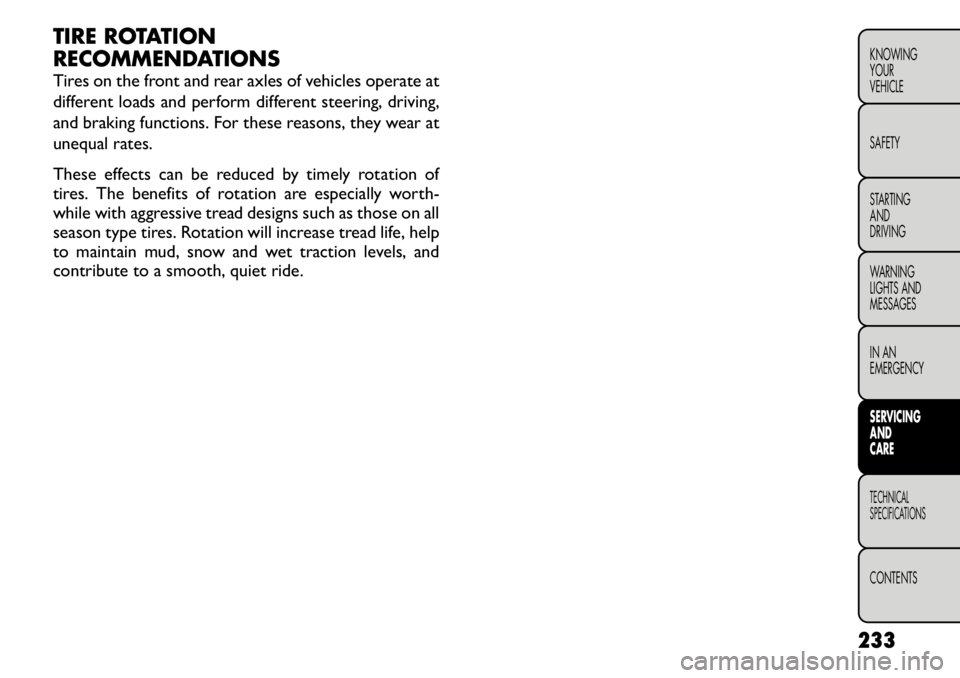
TIRE ROTATION
RECOMMENDATIONS
Tires on the front and rear axles of vehicles operate at
different loads and perform different steering, driving,
and braking functions. For these reasons, they wear at
unequal rates.
These effects can be reduced by timely rotation of
tires. The benefits of rotation are especially worth-
while with aggressive tread designs such as those on all
season type tires. Rotation will increase tread life, help
to maintain mud, snow and wet traction levels, and
contribute to a smooth, quiet ride.233
KNOWING
YOURVEHICLE SAFETY
STARTING ANDDRIVING
WARNING
LIGHTS AND
MESSAGES
IN AN
EMERGENCYSERVICING AND
CARETECHNICAL
SPECIFICATIONSCONTENTS
Page 243 of 267
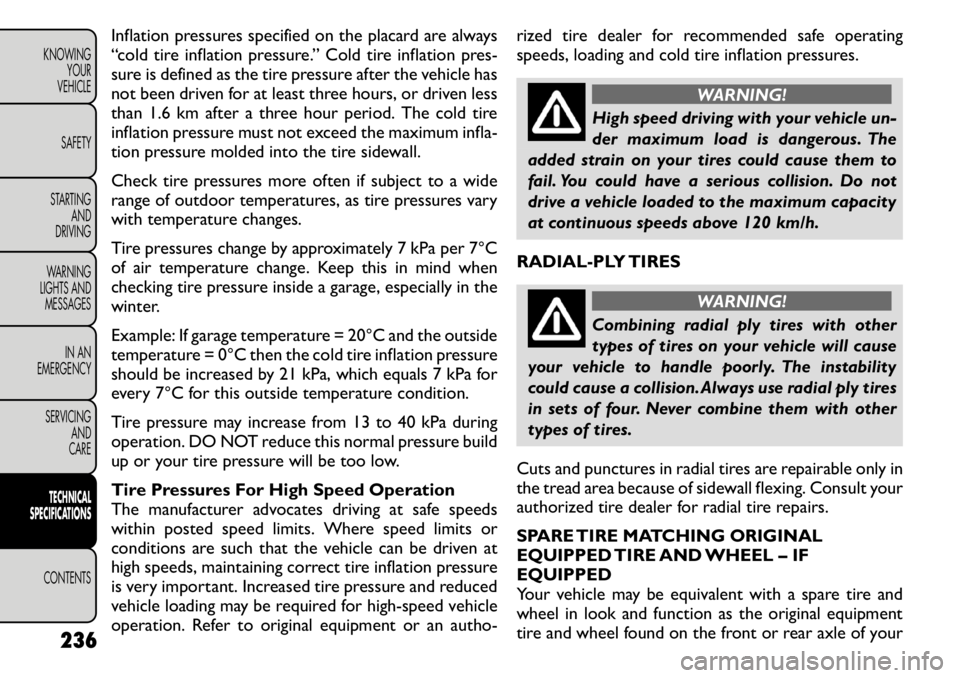
Inflation pressures specified on the placard are always
“cold tire inflation pressure.” Cold tire inflation pres-
sure is defined as the tire pressure after the vehicle has
not been driven for at least three hours, or driven less
than 1.6 km after a three hour period. The cold tire
inflation pressure must not exceed the maximum infla-
tion pressure molded into the tire sidewall.
Check tire pressures more often if subject to a wide
range of outdoor temperatures, as tire pressures vary
with temperature changes.
Tire pressures change by approximately 7 kPa per 7°C
of air temperature change. Keep this in mind when
checking tire pressure inside a garage, especially in the
winter.
Example: If garage temperature = 20°C and the outside
temperature = 0°C then the cold tire inflation pressure
should be increased by 21 kPa, which equals 7 kPa for
every 7°C for this outside temperature condition.
Tire pressure may increase from 13 to 40 kPa during
operation. DO NOT reduce this normal pressure build
up or your tire pressure will be too low.
Tire Pressures For High Speed Operation
The manufacturer advocates driving at safe speeds
within posted speed limits. Where speed limits or
conditions are such that the vehicle can be driven at
high speeds, maintaining correct tire inflation pressure
is very important. Increased tire pressure and reduced
vehicle loading may be required for high-speed vehicle
operation. Refer to original equipment or an autho-rized tire dealer for recommended safe operating
speeds, loading and cold tire inflation pressures.
WARNING!
High speed driving with your vehicle un-
der maximum load is dangerous. The
added strain on your tires could cause them to
fail. You could have a serious collision. Do not
drive a vehicle loaded to the maximum capacity
at continuous speeds above 120 km/h.
RADIAL-PLY TIRES
WARNING!
Combining radial ply tires with other
types of tires on your vehicle will cause
your vehicle to handle poorly. The instability
could cause a collision. Always use radial ply tires
in sets of four. Never combine them with other
types of tires.
Cuts and punctures in radial tires are repairable only in
the tread area because of sidewall flexing. Consult your
authorized tire dealer for radial tire repairs.
SPARE TIRE MATCHING ORIGINAL
EQUIPPED TIRE AND WHEEL – IFEQUIPPED
Your vehicle may be equivalent with a spare tire and
wheel in look and function as the original equipment
tire and wheel found on the front or rear axle of your
236
KNOWING
YOUR
VEHICLE
SAFETY
STARTING AND
DRIVING
WARNING
LIGHTS AND
MESSAGES
IN AN
EMERGENCY
SERVICING AND
CARETECHNICAL
SPECIFICATIONSCONTENTS
Page 251 of 267

ARRANGEMENTS FOR DEALING WITH THE VEHICLE AT THE END OF ITS LIFE
FIAT has been committed for many years to safeguarding the environment through the constant improvement of its
production processes and manufacturing products that are increasingly “eco-compatible”.
To give customers the best possible service in terms of respecting environmental laws and in response to European
Directive 2000/53/EC governing vehicles at the end of their life, FIAT is offering its customers the opportunity of handing
over their vehicle* at the end of its life without incurring any additional costs.
The European Directive sets out that when the vehicle is handed over the last keeper or owner should not incur any
expenses as a result of it having a zero or negative market value.
In all European Union countries, until 1st January 2007, only vehicles registered after 1st July 2002 were collected free of
charge, while since 2007 collection has been free of charge irrespective of the year of registration as long as the vehicle
contains its basic components (in particular, the engine and bodywork) and has no additional waste.
To hand your vehicle over at the end of its life without extra cost, go to one of our Dealerships or FIAT-authorized
collection and scrapping centres.
These centres have been carefully chosen to offer high quality service for the collection, treatment and recycling of unused
vehicles with respect to the environment.
You can find further information on these collection and scrapping centres either from a FIAT or FIAT Commercial Vehicle
Dealership or by calling the freephone number 00800 3428 0000 or by going on the FIAT website.
(*) Vehicle for transporting passengers with a maximum of nine seats and a total permitted weight of 3.5 t.244
Page 256 of 267
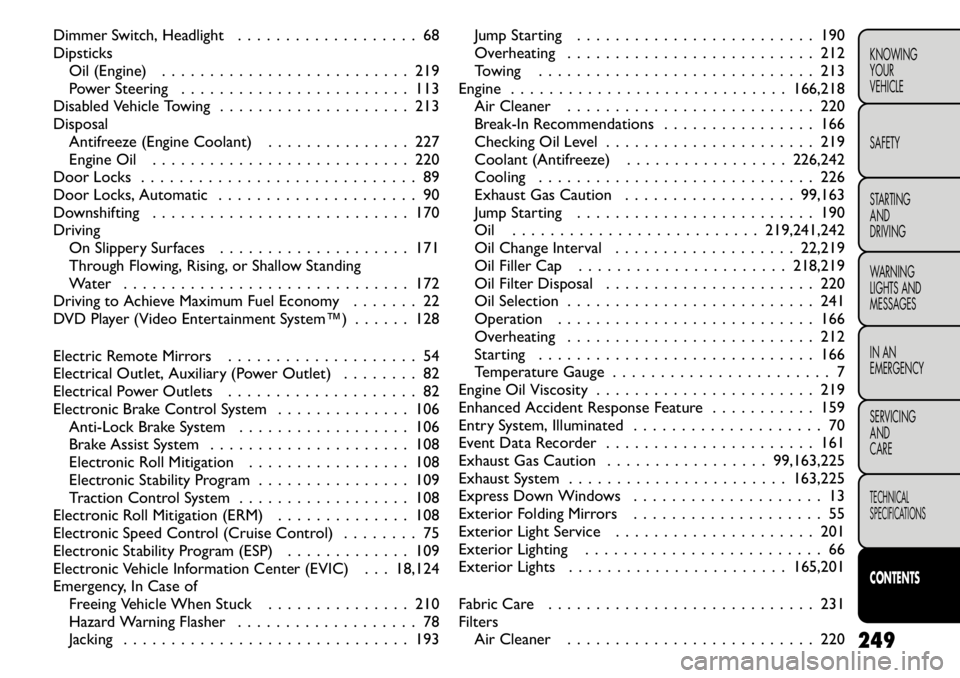
Dimmer Switch, Headlight . . . . . . . . . . . . . . . . . . . 68 DipsticksOil (Engine) . . . . . . . . . . . . . . . . . . . . . . . . . . 219
Power Steering . . . . . . . . . . . . . . . . . . . . . . . . 113
Disabled Vehicle Towing . . . . . . . . . . . . . . . . . . . . 213Disposal Antifreeze (Engine Coolant) . . . . . . . . . . . . . . . 227
Engine Oil . . . . . . . . . . . . . . . . . . . . . . . . . . . 220
Door Locks . . . . . . . . . . . . . . . . . . . . . . . . . . . . . 89
Door Locks, Automatic . . . . . . . . . . . . . . . . . . . . . 90
Downshifting . . . . . . . . . . . . . . . . . . . . . . . . . . . 170Driving
On Slippery Surfaces . . . . . . . . . . . . . . . . . . . . 171
Through Flowing, Rising, or Shallow Standing
Water . . . . . . . . . . . . . . . . . . . . . . . . . . . . . . 172
Driving to Achieve Maximum Fuel Economy . . . . . . . 22
DVD Player (Video Entertainment System™) . . . . . . 128
Electric Remote Mirrors . . . . . . . . . . . . . . . . . . . . 54
Electrical Outlet, Auxiliary (Power Outlet) . . . . . . . . 82
Electrical Power Outlets . . . . . . . . . . . . . . . . . . . . 82
Electronic Brake Control System . . . . . . . . . . . . . . 106 Anti-Lock Brake System . . . . . . . . . . . . . . . . . . 106
Brake Assist System . . . . . . . . . . . . . . . . . . . . . 108
Electronic Roll Mitigation . . . . . . . . . . . . . . . . . 108
Electronic Stability Program . . . . . . . . . . . . . . . . 109
Traction Control System . . . . . . . . . . . . . . . . . . 108
Electronic Roll Mitigation (ERM) . . . . . . . . . . . . . . 108
Electronic Speed Control (Cruise Control) . . . . . . . . 75
Electronic Stability Program (ESP) . . . . . . . . . . . . . 109
Electronic Vehicle Information Center (EVIC) . . . 18,124
Emergency, In Case of Freeing Vehicle When Stuck . . . . . . . . . . . . . . . 210
Hazard Warning Flasher . . . . . . . . . . . . . . . . . . . 78
Jacking . . . . . . . . . . . . . . . . . . . . . . . . . . . . . . 193 Jump Starting . . . . . . . . . . . . . . . . . . . . . . . . . 190
Overheating . . . . . . . . . . . . . . . . . . . . . . . . . . 212
Towing . . . . . . . . . . . . . . . . . . . . . . . . . . . . . 213
Engine . . . . . . . . . . . . . . . . . . . . . . . . . . . . . 166,218 Air Cleaner . . . . . . . . . . . . . . . . . . . . . . . . . . 220
Break-In Recommendations . . . . . . . . . . . . . . . . 166
Checking Oil Level . . . . . . . . . . . . . . . . . . . . . . 219
Coolant (Antifreeze) . . . . . . . . . . . . . . . . . 226,242
Cooling . . . . . . . . . . . . . . . . . . . . . . . . . . . . . 226
Exhaust Gas Caution . . . . . . . . . . . . . . . . . . 99,163
Jump Starting . . . . . . . . . . . . . . . . . . . . . . . . . 190
Oil . . . . . . . . . . . . . . . . . . . . . . . . . . 219,241,242
Oil Change Interval . . . . . . . . . . . . . . . . . . . 22,219
Oil Filler Cap . . . . . . . . . . . . . . . . . . . . . . 218,219
Oil Filter Disposal . . . . . . . . . . . . . . . . . . . . . . 220
Oil Selection . . . . . . . . . . . . . . . . . . . . . . . . . . 241
Operation . . . . . . . . . . . . . . . . . . . . . . . . . . . 166
Overheating . . . . . . . . . . . . . . . . . . . . . . . . . . 212
Starting . . . . . . . . . . . . . . . . . . . . . . . . . . . . . 166
Temperature Gauge . . . . . . . . . . . . . . . . . . . . . . . 7
Engine Oil Viscosity . . . . . . . . . . . . . . . . . . . . . . . 219
Enhanced Accident Response Feature . . . . . . . . . . . 159
Entry System, Illuminated . . . . . . . . . . . . . . . . . . . . 70
Event Data Recorder . . . . . . . . . . . . . . . . . . . . . . 161
Exhaust Gas Caution . . . . . . . . . . . . . . . . . 99,163,225
Exhaust System . . . . . . . . . . . . . . . . . . . . . . . 163,225
Express Down Windows . . . . . . . . . . . . . . . . . . . . 13
Exterior Folding Mirrors . . . . . . . . . . . . . . . . . . . . 55
Exterior Light Service . . . . . . . . . . . . . . . . . . . . . 201
Exterior Lighting . . . . . . . . . . . . . . . . . . . . . . . . . 66
Exterior Lights . . . . . . . . . . . . . . . . . . . . . . . 165,201
Fabric Care . . . . . . . . . . . . . . . . . . . . . . . . . . . . 231
Filters
Air Cleaner . . . . . . . . . . . . . . . . . . . . . . . . . . 220 249
KNOWING
YOURVEHICLE SAFETY
STARTING ANDDRIVING
WARNING
LIGHTS AND
MESSAGES
IN AN
EMERGENCY
SERVICING AND
CARETECHNICAL
SPECIFICATIONSCONTENTS
Page 259 of 267

Daytime Running . . . . . . . . . . . . . . . . . . . . . . . . 67
Dimmer Switch, Headlight . . . . . . . . . . . . . . . . . 68
Electronic Stability Program (ESP) Indicator . . . . . 110
Exterior . . . . . . . . . . . . . . . . . . . . . . . . . . . . . 165
Fog . . . . . . . . . . . . . . . . . . . . . . . . . . . 67,186,201
Fuses . . . . . . . . . . . . . . . . . . . . . . . . . . . . . . . 206
Hazard Warning Flasher . . . . . . . . . . . . . . . . . . . 78
Headlight Leveling . . . . . . . . . . . . . . . . . . . . . . . 69
Headlight Switch . . . . . . . . . . . . . . . . . . . . . . . . 66
Headlights . . . . . . . . . . . . . . . . . . . . . . . . . 66,201
Headlights On Reminder . . . . . . . . . . . . . . . . . . 67
Headlights On With Wipers . . . . . . . . . . . . . . . . 66
High Beam . . . . . . . . . . . . . . . . . . . . . . 68,186,201
High Beam Indicator . . . . . . . . . . . . . . . . . . . . 186
High Beam/Low Beam Select . . . . . . . . . . . . . . . . 68
Illuminated Entry . . . . . . . . . . . . . . . . . . . . . . . . 70
Instrument Cluster . . . . . . . . . . . . . . . . . . . 66,185
Intensity Control . . . . . . . . . . . . . . . . . . . . . . . . 68
Interior . . . . . . . . . . . . . . . . . . . . . . . . . . . . . . 68
License . . . . . . . . . . . . . . . . . . . . . . . . . . . . . 205
Lights On Reminder . . . . . . . . . . . . . . . . . . . . . . 67
Low Fuel . . . . . . . . . . . . . . . . . . . . . . . . . . . . 7,20
Low Tire . . . . . . . . . . . . . . . . . . . . . . . . . . . . 186
Malfunction Indicator (Check Engine) . . . . . . . . . 185
Map Reading . . . . . . . . . . . . . . . . . . . . . . . . . . . 69
Parade Mode (Daytime Brightness) . . . . . . . . . . . . 69
Park . . . . . . . . . . . . . . . . . . . . . . . . . . . . . . . 201
Passing . . . . . . . . . . . . . . . . . . . . . . . . . . . . . . 68
Reading . . . . . . . . . . . . . . . . . . . . . . . . . . . . . . 69
Rear Fog . . . . . . . . . . . . . . . . . . . . . . . . . 189,202
Rear Servicing . . . . . . . . . . . . . . . . . . . . . . 201,203
Rear Tail . . . . . . . . . . . . . . . . . . . . . . . . . . . . 203
Seat Belt Reminder . . . . . . . . . . . . . . . . . . . . . 187
Service . . . . . . . . . . . . . . . . . . . . . . . . . . . 200,201
Service Engine Soon (Malfunction Indicator) . . . . . 185Side Marker . . . . . . . . . . . . . . . . . . . . . . . . . . 201
Side Repeater . . . . . . . . . . . . . . . . . . . . . . . . . 203
Tire Pressure Monitoring (TPMS) . . . . . . . . . 114,186
Traction Control . . . . . . . . . . . . . . . . . . . . . . . 110
Turn Signal . . . . . . . . . . . . . . . . 68,165,186,201,203
Vanity Mirror . . . . . . . . . . . . . . . . . . . . . . . . . . 55
Warning (Instrument Cluster Description) . . . . . . 185
Load Floor, Cargo . . . . . . . . . . . . . . . . . . . . . . . . 100
Locks . . . . . . . . . . . . . . . . . . . . . . . . . . . . . . . . . 89 Auto Unlock . . . . . . . . . . . . . . . . . . . . . . . . . . 91
Automatic Door . . . . . . . . . . . . . . . . . . . . . . . . 90
Child Protection . . . . . . . . . . . . . . . . . . . . . . . . 92
Door . . . . . . . . . . . . . . . . . . . . . . . . . . . . . . . 89
Power Door . . . . . . . . . . . . . . . . . . . . . . . . . . . 90
Steering Wheel . . . . . . . . . . . . . . . . . . . . . . . . . 17
Low Tire Pressure System . . . . . . . . . . . . . . . . . . 114
Lower Anchors and Tether for CHildren
(LATCH) . . . . . . . . . . . . . . . . . . . . . . . . . . . 146,149
Lubrication, Body . . . . . . . . . . . . . . . . . . . . . . . . 223
Luggage Rack (Roof Rack) . . . . . . . . . . . . . . . . . . . 104
Maintenance Free Battery . . . . . . . . . . . . . . . . . . . 220
Maintenance Procedures . . . . . . . . . . . . . . . . . . . 219
Maintenance Schedule . . . . . . . . . . . . . . . . . . . . . 215
Maintenance, General . . . . . . . . . . . . . . . . . . . . . 219
Maintenance, Sunroof . . . . . . . . . . . . . . . . . . . . . . 89
Malfunction Indicator Light (Check Engine) . . . . . . . 185
Manual Transaxle . . . . . . . . . . . . . . . . . . . . . . 170,229 Downshifting . . . . . . . . . . . . . . . . . . . . . . . . . 170
Fluid Level Check . . . . . . . . . . . . . . . . . . . . . . 229
Frequency of Fluid Change . . . . . . . . . . . . . . . . 230
Lubricant Selection . . . . . . . . . . . . . . . . . . . . . 230
Map/Reading Lights . . . . . . . . . . . . . . . . . . . . . . . . 69
Marker Lights, Side . . . . . . . . . . . . . . . . . . . . . . . 201
Master Cylinder (Brakes) . . . . . . . . . . . . . . . . . . . 228
252
KNOWING
YOUR
VEHICLE
SAFETY
STARTING AND
DRIVING
WARNING
LIGHTS AND
MESSAGES
IN AN
EMERGENCY
SERVICING AND
CARETECHNICAL
SPECIFICATIONSCONTENTS